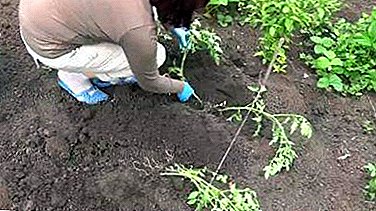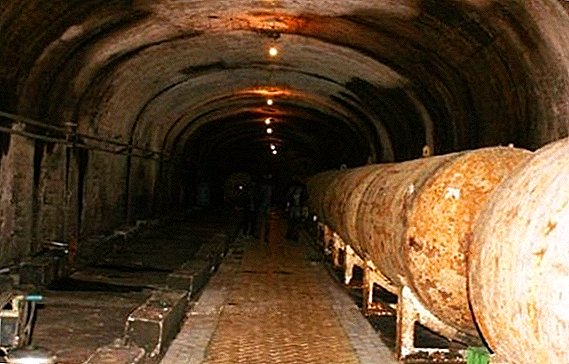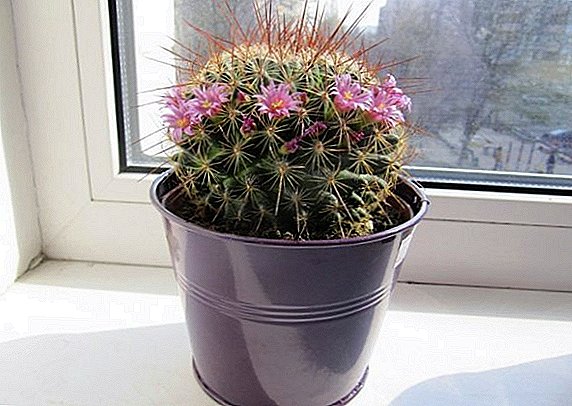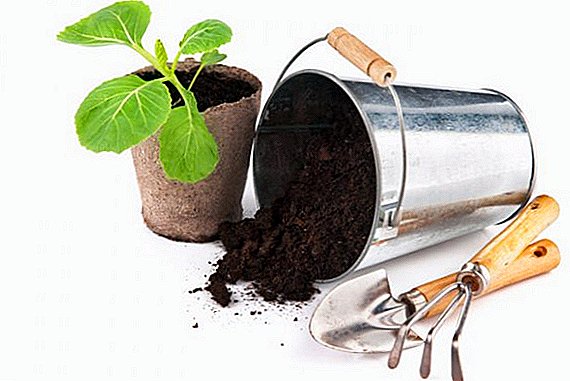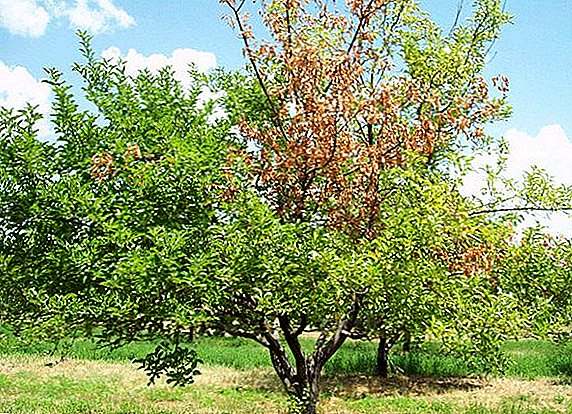 Moniliosis is a fungal disease that affects all fruit trees, including apricot, without exception. It is called spores of the fungus. In this article you will learn how these mushrooms can infect your apricots and how to fight them in order not to lose your orchard.
Moniliosis is a fungal disease that affects all fruit trees, including apricot, without exception. It is called spores of the fungus. In this article you will learn how these mushrooms can infect your apricots and how to fight them in order not to lose your orchard.
Description and harm
Garden trees are often sick, one of the most terrible diseases for them is a monilial burn. Yesterday you saw lush green trees resembling clouds, and today some branches are dry, as if they were freezing.
Learn more about the intricacies of growing apricot varieties such as "Prince of March", "Black Velvet", "Northern Triumph", "Black Prince", "Kuban Black".
Many fruit trees are susceptible to this disease; apple, quince, apricot, cherry, pear and peach do not bypass the disease. Infestation of trees with fungus is rapidly, first the flowers are affected, and then the whole apricot and its fruits. A negative consequence of the disease may be the loss of the crop, and then the whole tree. 
Did you know? The most well-known subspecies of this fungal disease are: Monilia cinerea, which strongly affects bone-stone cultures; Monilia fructigena, causing not very great damage, but rapidly spreading in pome crops (apple and pear); Monilia cydonia, which affects the quince.
Signs of appearance
Monilial burn of fruit trees is also known as gray rot. The appearance of this disease can manifest itself as:
- the bark of the affected tree is overgrown with light-gray pads that are formed from fungal spores;
- foliage and branches become dark brown in color and dry up, over time new greens may grow on the tree, but it will last only until the autumn season;
- on the tree affected by the disease, the yield will quickly decrease, only some of the fruits will survive, however, they will burst, rot and dry even green.
Causes and pathogen
The causative agent of this disease is the fungus Monilia, it is he who infects the tree through the pistil of a flower, then grows into a pedicel and through it enters the branch. In late spring, the disease manifests itself through the fallen ovaries and flowers, it may not manifest itself everywhere. At the beginning of the summer period, branches will dry in large numbers, and then fruits.
Low air temperature in the spring apricot flowering - the most favorable condition for the development of monilial burn. Often, even experienced gardeners write off fallen ovaries and leaves only on cold weather and strong wind. But such symptoms can mean a terrible disease of fruit trees.
Also fungal disease can occur from cloudy weather and high humidity. A long period of cold spring weather can provoke a massive disease with monilial burn of fruit trees. To defeat your apricot orchard, just a few cold days at the end of spring or infected tree growing from your neighbors is enough.
Important! When the tree blooms, moniliosis can hit it at a temperature of -1 ° C, and the ovary - from -0.6 WITH.

Fungus spores enter the tree through injuries and cracks in the bark and can winter there, as well as in the leaves and fruits that remain on the branches. Spores wake up when favorable conditions occur and begin to infect all surrounding plants. When the environment is warmer and wetter, the rot will begin to spread:
- by air;
- with raindrops;
- on parasites and insects.
To obtain a rich harvest of this useful fruit, you need to properly plant a tree (spring or autumn), fertilize, water, cut and provide protection from diseases and pests.
Resistant varieties
Today, in the places of sale of seedlings you can find many varieties of apricots, allegedly resistant to this disease. Sometimes seedlings of such varieties offer to buy in specialized nurseries, however, for a great price. However, it is not worthwhile to believe the talk about the complete stability of these apricots to monilial burn, since such varieties do not exist, and, probably, they are trying to lure you money.
However, it is worth noting that there are varieties of apricots, which have increased resistance to gray rot. That they should choose. Such trees cost only a couple of times per season to treat the agent, and you get healthy fruit. In ordinary varieties, even regular spraying does not always give results.
Along with the new bred varieties, the old varieties bred at the beginning of the twentieth century, such as Early Melitopol and Tsyurupinsky pineapple, have increased resistance.

Did you know? Initially, wild apricots appeared in two remote areas in Central Asia and North China. Scientists believe that people began to domesticate apricots in both areas about the same time.There are also promising new varieties that are declared with increased resistance to moniliose burn: "Star", "Mliyevsky radiant", "Melitopol 12908", "Red-cheeked", "Fortune".
Healing and fighting
The fight against apricot moniliosis is very difficult, because even potent chemicals are not easy to handle with this disease. The main prevention is planting the most viable, disease-resistant varieties.
Flower rosettes and fruit branches (which will later be the source of the disease), affected by moniliasis, need cut to healthy apricot wood and burn, the same should be done with the affected fruits. This treatment procedure should be carried out immediately after the wilting of the leaves, as well as two to three weeks after flowering.
Apricot processing after the discovery of the disease may not be very effective, because part of the crop may be lost. therefore spend processing the garden before flowering and repeat after the flowers fall.
Gardeners are advised to use highly effective fungicides to treat this apricot disease. At low temperatures at the beginning of spring, for example, the chemical agent Horus will be effective. After that, you can apply other fungicides: "Hamair", Bordeaux mixture, copper sulphate, "Rovral", "Abiga-Peak".
These chemicals are very effective in combating diseases that cause fungal spores. The mixture should be checked before spraying on several separate branches. If gray necrotic spots appear on the leaves, then this remedy should not be used. You should also not exceed the concentration of the substance specified in the instructions.
Important! This fungus has a very small incubation period; in just 3-6 days it can hit a tree.
Preventive measures
Experienced gardeners agree that modern fungicides are not so effective in combating moniliac burns, therefore, it is better to protect the tree from rot beforehand by using preventive measures.Plant apricots are not too thick, the distance between the trunks should not be less than 4-5 meters.
In the affected apricot, treat the places of the trimmed branches with the garden pitch, the skeletal branches at the bottom of the tree and the trunk should be treated with copper sulphate mixed with lime or Bordeaux mixture. Regularly destroy between apricots overgrown with weeds. Should also dig up the plant stem after the leaves fall off. Before processing apricots, they need to be cut so that the spraying process is most effective.

If there is a threat of infection by moniliac burns in rainy weather (after flowering or at the end of flowering), apricots should be treated with a 0.3% solution of copper oxychloride (30 g per 10 l of water) or a 0.1% solution of Topsin-M (10 g per 10 l of water). Gardeners also recommend treating the plant with a 0.015-0.02% Skor solution (1.5-2 ml per 10 liters of water).
It must be remembered that proper care of the plant will significantly reduce the likelihood of its infection with spores of the fungus.
From our article, you learned what gray rot is, how it affects apricot trees and how to deal with moniliosis if it occurs in your garden. Buy varieties resistant to this disease and do not forget about prevention.


